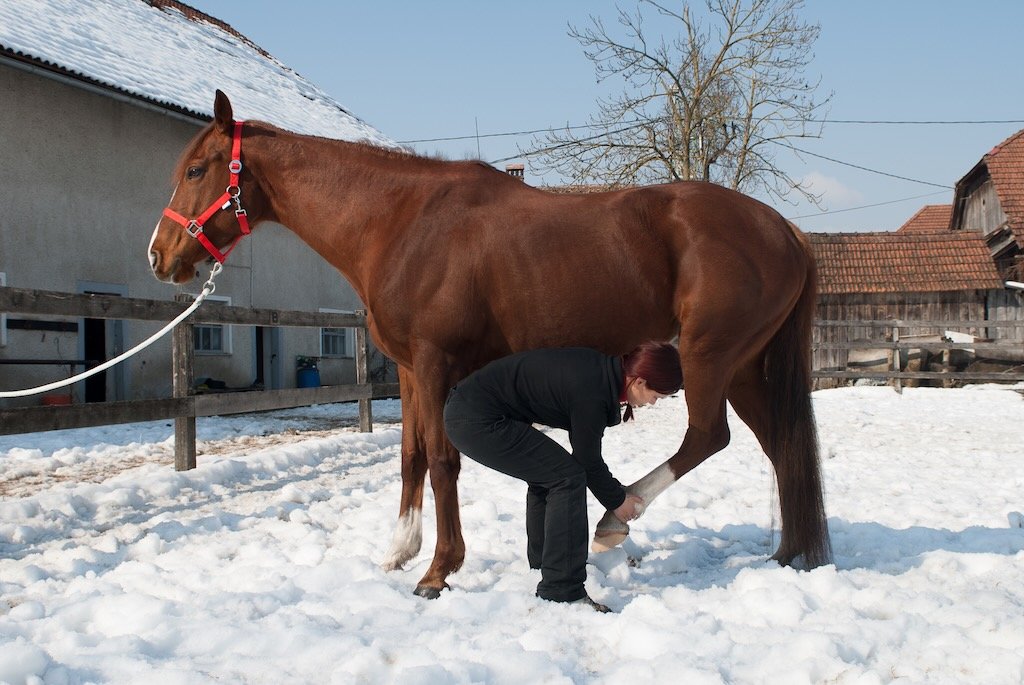When you pick up your horse's leg...
A healthy horse should be able to effortlessly stand on three legs while you pick up the fourth one. If this is a struggle, it is worth investigating.
When picking up the hind leg, the horse should lift it up slowly and evenly, with no jerking motion and should be able to stay relaxed while holding it up in different positions.
Something I've been paying more and more attention to is how the horse copes with picking up a leg. I notice that a lot of horses actually struggle to stand balanced and effortlessly on three legs. So, next time you're picking up your horse's leg, pay attention to what he has to say about it.
Standing on three legs should not be a difficult task for a healthy horse. But, in my work I often find that horses have a hard time with it. I also often notice that owners are aware of the fact that their horse has a hard time picking up a leg, but they rarely pay any attention to it. If your horse is struggling to stand on three legs, there is probably an underlying issue present. One thing I see often is a horse cocking his hind leg when the diagonal front is picked up. So, if you were to pick up his left front, he would cock his right hind. Sometimes this is bilateral, but more often it is one side only. If this happens every time we pick up a leg, it most likely indicates an issue somewhere along the fascial lines. According to fascia expert Dr. Rikke Schultz, this can indicate an issue in the functional line – the line that represents the functional connection between the diagonal legs. Some horses don't go as far as to cock the leg, but they might prefer to shift one of the hind legs into a different position – perhaps more towards the midline, or perhaps they will always want to have one of the hind legs in front of the other. This is all valuable information. It tells us that the horse has a problem with balance.
The issue with standing on three legs is often more noticeable in the hind legs – the horse might be reluctant to pick up one leg, or he might have a hard time standing on three legs for a longer period of time. Sometimes, this can be because of an issue in the contralateral leg. So, if there is pain in the weigh bearing structures of the left hind, for example, lifting the right hind and effectively putting more weight on the left hind, might be an issue. These horses will often slam the leg down with little to no warning, or they will attempt to lift the standing leg – both of these scenarios can be very dangerous both for the horse and the person holding the leg. Sometimes, the horse will jerk up a hind leg and pull it close to the belly before relaxing it downwards. This often indicates an issue higher up and it might involve the sciatic nerve. Or, sometimes holding the leg up is ok, but certain positions are not. Maybe the horse does not tolerate if the leg is held in abduction (away from the body) – can be indicative of hock issues, or he might not be able to bring it backwards – could signify a hip flexor issue. There are so many things we can learn from observing just how well the horse copes on three legs. Now, if your horse is a bit fussy with one leg on a hot day when there are a million flies bothering him, it's probably not a reason to panic. If, however there is a constant pattern of poor cooperation, this is probably worth investigating. So, next time you are picking up your horse's legs, pay attention to his posture, to how much effort it takes for him to stand on three legs and whether or not he can stay balanced while you move the leg into different positions. If you keep seeing the same pattern, consult a professional.
